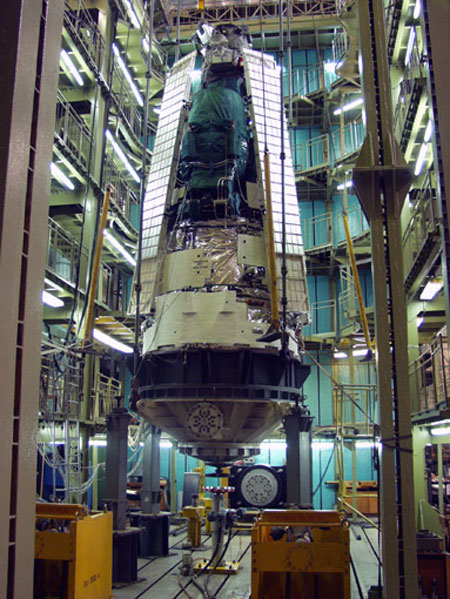Mysterious Dark Matter Possibly Detected

When dark matter is destroyed, it leaves behind a burst ofexotic particles, according to theory. Now scientists have found a possiblesignature of these remains. The discovery could help prove the existence ofdark matter and reveal what it's made of.
No one knows what dark matter is, but scientists think itexists because there is not enough gravity from visible matter to explain howgalaxies rotate.
An Italian satellite called PAMELA(Payload for Antimatter Matter Exploration and Light nuclei Astrophysics), launched in2006 to measure radiation in space, found an overabundance of particlescalled positrons, which are the antimatter counterpart to electrons (matterand antimatter annihilate each other).
This positron signature could have a variety of causes, buta prime candidate is dark matter, theintangible stuff thought to make up about 98 percent of all matter in theuniverse. When two darkmatter particles collide they can sometimes destroy each other and releasea burst of energy that includes positrons.
"PAMELA found a number of positrons much higher thanexpected," the mission's principal investigator Piergiorgio Picozza told SPACE.com."Many think this could be a signal from dark matter, because for positronsthis behavior fits very well with many theories of dark matter."
The finding, detailed in tomorrow's issue of the journal Nature,is not a total surprise, but it could be a huge splash, if confirmed.
"This kind of signal for dark matter has been predictedas a possible leading signature for over two decades, and [the PAMELAscientists] are seeing just the kind of things one might expect," saidUniversity of Michigan astrophysicist Gordon Kane, who was not involved in theresearch. "There's a very good chance that this is the most importantdiscovery in basic physics for decades."
Get the Space.com Newsletter
Breaking space news, the latest updates on rocket launches, skywatching events and more!
Positrons are often created when cosmic rays interact withatoms in the gas and dust between stars. But this source cannot produce enoughpositrons to account for PAMELA's findings. Another possibility is that thepositrons PAMELA found were produced by dense spinning stars called pulsars. Todistinguish between this option and dark matter, more data will be necessary,either from PAMELA or from the Fermi Gamma-ray Space Telescope, launched lastyear.
"We hope to have detected dark matter, but now we needother verification coming from other experiments," Picozza said.
Even so, some scientists are excited to have come so closeto possibly discovering the presence of dark matter, which has eluded researcherssince it was first conceived in the 1930s.
Kane emphasized that the results, though still not certain,could be significant not just as proof that dark matter exists, but also forclues about what makes up this mysterious substance, which cannotbe directly seen and is only detected via its gravitational tug on otherthings.
Kane's personal bet for the particle behind dark matter inthese findings is called a wino (pronounced WEE-no) ? a specific type ofneutralino, which is a theorized category of particles that could exist as"supersymmetric partners" for all the Standard Model particles suchas electrons, quarks, etc. The wino is the supersymmetric partner of a particlecalled the W boson.
"It does particularly well at producing positrons inthe annihilation, and the positrons have energies that are about right forthese results," Kane said in a phone interview.
If dark matter is made up of neutralinos, then dark matterparticles would be their own antimatter particles, because the anti-neutralinois simply a neutralino. Thus, when two dark matter particles collide, they canself-destruct like any other interaction of matter and anti-matter.
Luckily, this does not happen very often. Dark matterparticles are thought to be extremely tiny, and the chances of them hittingeach other perfectly square on, and under the right conditions for destruction,are very low. This fact allows dark matter to clump together throughout theuniverse, scaffolding up galaxies and clusters, without destroying itself everytime two dark matter particles come near each other.
Even though annihilations are rare, the positrons theyproduce could survive for up to a few million years, so they can stick aroundlong enough for detectors like PAMELA to find them.
- Understanding Dark Matter
- Top 10 Strangest Things in Space
- Video: Dark Matter in 3-D
Join our Space Forums to keep talking space on the latest missions, night sky and more! And if you have a news tip, correction or comment, let us know at: community@space.com.

Clara Moskowitz is a science and space writer who joined the Space.com team in 2008 and served as Assistant Managing Editor from 2011 to 2013. Clara has a bachelor's degree in astronomy and physics from Wesleyan University, and a graduate certificate in science writing from the University of California, Santa Cruz. She covers everything from astronomy to human spaceflight and once aced a NASTAR suborbital spaceflight training program for space missions. Clara is currently Associate Editor of Scientific American. To see her latest project is, follow Clara on Twitter.









